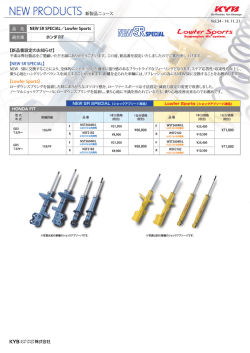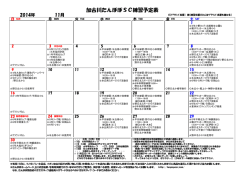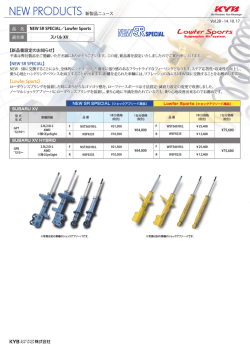
特別講演 1
3/18(Wed) Room A 9:00 ∼ 10:00 [座長] 飯野 正光(東京大学大学院医学系研究科 細胞分子薬理学) [Chair] Masamitsu Iino(Dept. Pharmacol., Grad. Sch. Med., Univ. Tokyo) SL1 iPS 細胞と遺伝子改変霊長類を用いた神経疾患の病態解明 と創薬研究 Modeling Psychiatric/Neurological disorders using iPS cell technologies and transgenic non-human primates 慶應義塾大学医学部 生理学教室 Hideyuki Okano Department of Physiology, Graduate School of Medicine, Keio University 少子高齢化の中でも認知症の患者の増加は、社会的にも最も重大な脅威となっている。我々は、 この問題に対処すべく、アルツハイマー病患者由来の iPS 細胞を樹立し、病態解析を行い、超 早期における治療薬の探索を行った。患者皮膚線維芽細胞から樹立した iPS 細胞由来の神経細 胞は、数週間以内という比較的早期に生化学的な異常所見を示し、早期診断に有効である可能 性を示した。また、我々は遺伝子改変技術を用いてアルツハイマー病モデルマーモセットの開 発に成功し、in vivo でのアプローチを計画しており、これらを活用したアルツハイマー病の先 制医療の開発に着手した。本講演では、これまでの成果と今後の展望について話したい。 What makes the investigation of human psychiatric/psychiatric disorders so difficult? In order to overcome these difficulties, we took advantage of iPS cell technologies and transgenic non-human primates for modeling human psychiatric/psychiatric disorders. So far, we have established iPS cells from the patients of about 30 human psychiatric/psychiatric disorders and characterized their pathophysiology. For faithfully modeling the human psychiatric/psychiatric disorders in vivo, we developed transgenic non-human primates (common marmosets) with germline transmission (Sasaki et al., Nature, 2009). In the present talk, we also wish to mention our recent data of generation of common marmoset transgenic models of neurodegenrerative diseases, including Parkinson disease, Alzheimer disease and ALS. Furthermore, we could generate knock-out technologies of common marmoset using genome editing technologies for the generation of transgenic marmoset model of autism and psychiatric disorders. At the end, I will mention about Brain Mapping Projects in Japan, in which investigation of common marmoset brains plays key roles. 3/19(Wed)Special Symposium 3/19(Wed)Special Symposium 岡野 栄之 3/18(Wed)Special Lectures 特別講演 1 Special Lecture 1 45 3/18(Wed)Special Lectures 特別講演 2 Special Lecture 2 3/18 (Wed) Room A 10:00 ∼ 11:00 [座長] 矢部 千尋(京都府立医科大学大学院医学研究科 病態分子薬理学) [Chair] Chihiro Yabe(Dept. Pharmacol., Kyoto Pref. Univ. Med.) SL2 Inflammation and immune mechanisms of brain damage after stroke 3/19 (Wed)Joint Symposium Christopher G. Sobey Department of Pharmacology, Monash University, Australia 3/19(Wed)Special Symposium Stroke accounts for more than 10% of deaths worldwide, and over a third of survivors are left with major neurological impairment. The need for new and effective therapies for stroke is therefore clear and urgent. While some advances have been made toward understanding its mechanisms, still only one intervention has been found to reduce brain injury following clinical stroke - the 'clot-buster' recombinant tissue plasminogen activator. Unfortunately however, with a short time window of only 4.5 h, this therapy is available to less than 10% of stroke patients. For further advances in the clinical treatment of ischemic stroke, the complex mechanisms of cellular injury following cerebral ischemia must be elucidated to provide novel targets for future therapies. The initial ischemic insult is now known to be followed by induction of cytokines and chemokines, which attract numerous inflammatory cell types to the damaged brain region and ultimately contribute to secondary brain injury. Neutrophils, monocytes, T and B lymphocytes may each become activated, infiltrate the brain and modulate the severity of stroke outcome. This presentation will describe some of our recent work targeting various immune cell mechanisms for novel therapies in acute stroke. ※オーストラリア・ニュージーランド薬理学会からの招待講演 46 3/18 (Wed) Room A 11:00 ∼ 12:00 [座長] 谷内 一彦(東北大学大学院医学系研究科 機能薬理学) [Chair] Kazuhiko Yanai(Dept. Pharmacol., Tohoku Univ. Sch. Med.) SL3 神経変性疾患の disease-modifying therapy 開発を めざして Perspectives of disease-modifying therapy for neurodegenerative disease 名古屋大学大学院医学系研究科 神経内科 Gen Sobue Department of Neurology, Nagoya University Graduate School of Medicine これまで神経変性疾患に関する数多くの動物モデルの開発と解析が進められている。しかし現 在、病態を確実に抑える治療法はない。 球脊髄性筋萎縮症(SBMA)は男性成人発症の下位運動ニューロン疾患であり、四肢筋力低下・ 筋萎縮と球麻痺を生じる。原因はアンドロゲン受容体(AR)遺伝子の CAG リピートの異常 延長である。我々は、変異 AR タンパク質が運動ニューロンの核内にテストステロン依存性に 集積し、神経細胞の機能障害を惹起することを明らかにし、テストステロン分泌抑制剤である リュープロレリンが著明に病態を改善し、さらに SBMA 患者でも変異 AR の集積が抑制され症 状の改善が示された。 我々はリュープロレリン以外に、SBMA の病態を担ういくつかの標的分子を明らかにしてきて いる(miR196a、CGRP-1、Hsp90 など)が、本発表では今後広く神経変性疾患の病態抑止治 療を開発するために、どのようなストラテジーが重要かを考えたい。 Spinal and bulbar muscular atrophy (SBMA) is an adult-onset motor neuron disease caused by the expansion of a trinucleotide CAG repeat, which encodes the polyglutamine tract, within the first exon of the androgen receptor (AR) gene. The ligand-dependent accumulation of the pathogenic AR, an initial step in the neurodegenerative process in SBMA, is followed by several downstream molecular events such as transcriptional dysregulation and axonal transport disruption. Androgen deprivation through leuprorelin improved the symptoms, histopathological findings, and nuclear accumulation of the pathogenic AR in the male AR-97Q mice. In a largescale randomized clinical trial, leuprorelin treatment was associated with a greater reduction in barium residue than was placebo. We also identified miR-196a CGRP-1, HSPs, etc, as molecules which regulate disease pathophysiology of SBMA, and thus these are the target for disease-modifying therapy for neurodegenerative diseases. 3/19(Wed)Special Symposium 3/19(Wed)Special Symposium 祖父江 元 3/18(Wed)Special Lectures 特別講演 3 Special Lecture 3 47 3/18(Wed)Special Lectures 特別講演 4 Special Lecture 4 3/18 (Wed) Room A 13:30 ∼ 14:30 [座長] 中谷 晴昭(千葉大学大学院医学研究院 薬理学) [Chair] Haruaki Nakaya(Dept. Pharmacol., Chiba Univ. Grad. Sch. Med.) SL4 NMR による創薬標的タンパク質の機能解明 Functional analyses of target proteins for drug development by NMR 3/19 (Wed)Joint Symposium 嶋田 一夫 東京大学大学院 薬学系研究科 Ichio Shimada Graduate School of Pharmaceutical Sciences, The University of Tokyo 3/19(Wed)Special Symposium G タンパク質共役型受容体 (GPCR) およびカイネーズなどの創薬標的タンパク質は生体内で重 要な役割を果たしている。X 線結晶構造解析法はそれらの立体構造を明らかにし、薬学研究分 野において貢献してきた。一方、タンパク質は、リガンド結合などの刺激に応じて構造・運動 性を変化させることで機能する。そのため、機能発現メカニズムを解明するには結晶構造(だ けでなく、機能発現時にどのような構造変化が起こるのかといった時間軸を含んだ構造情報が 必要である。核磁気共鳴法(NMR)は、この要求にこたえる最もふさわしい構造生物学的手法 である。ここでは、複数の創薬標的タンパク質を対象として NMR による機能解明の研究例を 紹介する。 G-protein coupled receptors (GPCR) and kinases play fundamental roles in many physiological processes and also are target proteins for drug development. However, it is frequently difficult to obtain structural information about the membrane protein dynamics related to the functions. This is mainly due to the difficulties in sample preparation: expression and purification of the membrane proteins with the biological activities, and lack of appropriate NMR strategy. In this paper, we will show our recent results of dynamical aspects of GPCR and mitogen-activated protein kinases (MAPKs), which are responsible for the biological functions. 1) Kofuku,Y., et al., Nat. Commun. doi: 10.1038/ncomms2046 (2012) 2) Kofuku,Y., et al., Angew. Chem. Int. Ed. Engl. doi: 10.1002/anie.201406603 (2014) 3) Tokunaga,Y., et al., Nat. Struct. Mol. Biol. 21, 704-11 (2014) 4) Takeuchi K., et al., Sci. Rep. 4, 6922, (2014) 48 3/18 (Wed) Room A 16:40 ∼ 17:40 [座長] 石井 邦雄(北里大学薬学部 分子薬理学) [Chair] Kunio Ishii(Dept. Mol. Pharmacol., Kitasato Univ. Sch. Pharm. Sci.) SL5 薬理学の特徴を活かした脳機能の解析 Analysis of brain functions with pharmacological perspectives 東京大学 名誉教授 Norio Matsuki Emeritus Professor of The University of Tokyo 薬理学の特徴は、薬の作用機序を明らかにすることと生体に対する薬の作用を包括的に理解で きる点にあるが、分子生物学や遺伝子工学などの発展により、薬理学の分野でも要素還元的ア プローチが主流である。こうした知見は個体レベルの行動薬理学とはなかなか結びつかず、脳 機能の解明や中枢神経系疾患治療薬の開発が遅れている一因となっている。本講演では、ミク ロの解像度を維持しつつ解析対象を時間的、空間的に拡大することで得られた知見について解 説する。胎生期や乳幼児期のストレスが成熟した後も脳神経に構造的・機能的な影響を及ぼし、 てんかんの原因ともなる。海馬の神経伝達は海馬内・海馬外の神経活動により調節される。記憶・ 学習が直接関係しないと考えられている脳部位や末梢の活動により影響される。最後に、薬理 学の強味を活かした今後の展望について述べる。 Analysis of the mechanism of drug actions as well as comprehension of true nature of drugs are strong points of the pharmacology, which cannot be accomplished with reductionism. The knowledge between molecular level and individual behavior level is still a black box. Broader temporal and spatial analysis of neural activities with concomitant micro-level resolution reveal novel contrivance of brain function. We have found that febrile seizure of neonates induces abnormal location of granule cells in the hippocampus via upregulation of GABA receptors that persists into adulthood. Hippocampal neural activities are modified by intra- and extrahippocampal active levels. Complex inter-nuclei interactions are important for accomplishment of fear memory in which amygdala plays a crucial role. Brain function is not free from peripheral activities. Activation of vagus afferents bidirectionally affects synaptic activities in the hippocampus as well as formation of memory. Personal view of prospective direction of pharmacology will be addressed. 3/19(Wed)Special Symposium 3/19(Wed)Special Symposium 松木 則夫 3/18(Wed)Special Lectures 特別講演 5 Special Lecture 5 49 3/19(Thu)Special Lecture 特別講演 6 Special Lecture 6 3/19 (Thu) Room C 9:00 ∼ 10:00 [座長] 金子 周司(京都大学大学院薬学研究科 生体機能解析学) [Chair] Shuji Kaneko(Dept. Mol. Pharmacol., Grad. Sch. Pharmaceut Sci., Kyoto Univ.) SL6 The magic of calcium ion entry: discovery, disease and drugs 3/19(Thu)Special Lectures David J. Beech Faculty of Biological Sciences, University of Leeds, UK 3/19(Wed)Special Symposium Calcium is important not only for the structure of bone but also for signaling in every cell of the body. There is a huge concentration gradient into cells and multiple mechanisms exist to regulate its entry. Once in the cell calcium profoundly influences many process depending on amplitude, space and time. Entry via voltage-gated calcium channels often leads to excitation, for example in the form of muscle contraction and neurotransmitter release. These channels are inhibited by drugs such as amlodipine and pregabalin, used to treat hypertension and neurological conditions such as neuropathic pain in diabetes. But many other types of calcium channel have been discovered over the past 20 years: gated not by voltage but other factors. They exist also in non-excitable cells and many are up-regulated in common diseases. We are investigating these other channels which include Piezo channels, identified 5 years ago as mechanical impact sensors in nociceptive neurones. Recently we identified importance of Piezo1 as a frictional force sensor of endothelial cells, showing its critical role in development (Li et al 2014 Nature doi: 10.1038/nature13701). We are now developing small-molecule modulators of non-voltage-gated calcium-permeable channels to facilitate studies of their biology and explore their potential for drug discovery. ※本特別講演は、新学術領域「酸素生物学」との合同企画です。 助成:公益財団法人 中冨健康科学振興財団(国際交流助成金) 50 3/19 (Thu) Room A 11:00 ∼ 12:00 [座長] 原 英彰(岐阜薬科大学 薬効解析学) [Chair] Hideaki Hara(Dept. of Biofunctional Evaluation, Gifu Pharm. Univ.) SL7 Post-translational regulaiton of NF-κB signaling at the angle of methylation Department of Pharmacology, College of Medicine, Chungnam National University, Republic of Korea 3/19(Wed)Special Symposium It has been well established that NF-κB activation must be kept temporally and spatially in check by well-orchestrated negative feedback loops to protect excessive activation. However, in cancer cells, these feedback loops are overridden through unclear mechanisms to sustain a constitutive activation of NF-κB signaling. The topic will be present and discuss how we made a novel discovery that tudor domain containing protein, PHF20 is a key protein to maintain NF-κB in a default active state. Here, we show that, in PHF20 overexpressing cells, the termination of TNF-induced p65 phosphorylation is impaired while the upstream signaling events triggered by TNF are not affected. More importantly, the involvement of PHF20 in this process is specifically and highly contingent upon its interaction with Lys methylated-p65 which interrupts the recruitment of protein phosphatase PP2A to p65 and thus leads to a prolonged p65 phosphorylation. Thus, here we propose a new molecular mechanism of constitutive NF-κB activation by PHF20 recognizes the methylation status of p65 in the context of pathologic conditions such as inflammation-linked cancer development. 3/19(Thu)Special Lectures Gang-Min Hur 3/19(Thu)Special Lecture 特別講演 7 Special Lecture 7 ※韓国薬理学会からの招待講演 51 3/19(Thu)Special Lecture 3/19(Thu)Special Lectures 3/19(Wed)Special Symposium 52 特別講演 8 Special Lecture 8 3/19 (Thu) Room A 17:10 ∼ 18:10 [座長] 今井 由美子(秋田大学医学部 情報制御学実験治療学講座) [Chair] Yumiko Imai(Dept. Biol. Informatics and Exp. Therapeutics, Grad. Sch. Med., Akita Univ.) SL8 DNA 損傷応答機構とこれらを標的とした新たながん治療薬 の可能性 DNA damage responses and their potential use as therapeutic targets for malignant tumors 中西 真 名古屋市立大学大学院医学研究科 細胞生化学分野 Makoto Nakanishi Department of Cell Biology, Graduate School of Medical Sciences, Nagoya City University 真核細胞は DNA 損傷、酸化的ストレス、あるいはがん遺伝子活性化等のゲノムストレスを受 けると DNA 損傷応答を活性化させる。これにより一過性細胞周期停止、アポトーシス、ある いは早期細胞老化などの細胞応答が誘導されることで、細胞の腫瘍化を防いでいる。DNA 損傷 応答機構はゲノムストレス存在下において、細胞そのものの生存に必須である。しかしながら、 多くのがん細胞ではこの機構の一部に異常が生じることで適切な細胞応答が誘導されず、広範 なゲノム不安定化により悪性化すると考えられている。本講演では、DNA 損傷応答活性化によ る細胞応答誘導機構の詳細を概説し、これらを標的としてがん細胞特異的に合成致死を誘導す る新たながん治療薬の可能性について議論したい。 DNA damage responses (DDR) are important surveillance systems to maintain genomic integrity. Once genomic stresses such as DNA damage, oxidative stress, and activation of oncogenes are sensed, DDR execute transient cell cycle arrest through inhibition of the activity of cell cycle regulators. DDR also trigger apoptosis and cellular senescence when cells sense severe and extensive chromosomal abnormalities. Numerous key players have been identified in terms of damage sensor proteins, transducer kinases and effectors, but their coordination, interconnectedness, and the mechanisms by which they regulate important anti-tumor protective responses have become evident only recently. Under genomic stresses, cell survival is completely dependent on these mechanisms. However, most cancer cells defect a part of DDR, leading to gross genomic instability and malignant transformation. These observations also indicate that survival of cancer cells depends on the residual DDR. Thus, inhibitors for the residual DDR might be effective and specific drugs for most cancers through inducing synthetic lethality. In this talk, I would like to introduce details of DDR and discuss about their potential use as therapeutic targets for malignant tumors. 3/20 (Fri) Room A 9:00 ∼ 10:00 [座長] 田中 利男(三重大学大学院医学系研究科 薬理ゲノミクス) [Chair] Toshio Tanaka(Dept. Pharmacogenomics, Mie Univ. Grad. Sch. Med.) SL9 レニン・アンジオテンシン系研究と心血管病 Renin angiotensin system and cardiovascular diseases 四天王寺大学 教育学部 Hiroshi Iwao Department of Education, Shitennoji University 3/20 (Fri)Special Lectures Tigerstedt と Bergmann により 1898 年にレニンが発見されてから約 115 年が経過した現在、 レニン・アンジオテンシン系(RA 系)の研究は一段落ついたように思われます。レニン・ア ンジオテンシン系の研究が急速に発展し始めた 1970 年代後半からを振り返り、今後の展望を 考えたいと思います。この 40 年を振り返ると、レニンの精製、レニン・アンギオテンシノー ゲン・変換酵素の遺伝子クローニング、トランスジェニック動物やノックアウト動物などの遺 伝子改変動物の作成、レニン・アンジオテンシン系の阻害薬(変換酵素阻害薬、アンジオテン シン受容体拮抗薬、レニン阻害薬)の開発などが達成され、高血圧を中心とした心血管系疾患 の治療に貢献してきました。近年では RA 系の中枢での役割、2型アンジオテンシン受容体作 用薬、アンジオテンシン 1 − 7、プロレニンなどの研究が進められています。また、心血管病 は慢性炎症の一つとしてとらえられるようになり、これに伴い組織のリモデリングと細胞や組 織の障害が引き起こされると考えられるようになってきました。そこで、我々は、持続的な高 血圧による内皮細胞障害を引き起こす新たな因子の探索を始め、異種細胞間連絡を担う分子と して知られている細胞外小胞の exosome に注目しました。直径 30-100 nm の小さな exosome は、ドナー細胞由来のタンパク質や核酸を選択的に梱包し、またマーカー分子の heat shock proteins(Hsp70、Hsp90)や tetoraspanin(CD9、CD63 など)を含み、これらはレシピエ ント細胞の受容体を介した膜表面または膜融合による細胞内でのシグナル伝達を引き起こすと 考えられています。アンジオテンシンによる高血圧モデルラットならびにマウスの血中にマク ロファージ由来の exosome が増加し、血管内皮細胞の膜表面に存在する toll-like receptor 4 を 介して細胞障害性シグナル伝達を引き起こす可能性を有していたことから、慢性高血圧による 組織リモデリングに関与する新たな因子として着目しています。 3/20 (Fri)Special Lecture 岩尾 洋 3/19(Thu)Special Lecture 特別講演 9 Special Lecture 9 Tigerstedt and Bergmann discovered renin in 1898. Recent 40 years renin-angiotensin research has been rapidly promoted in fields of protein chemistry, molecular biology, genetically-modified animals, and drug discovery. The inhibitors of renin-angiotensin system contribute to the therapy in cardiovascular diseases. Short review of these findings and ongoing topics will be made comments. Cardiovascular diseases have cross interactions with chronic inflammation. In these circumstances exosome play a role on cell to cell communications. Exosome contains many intracellular components such as DNAs, RNAs, proteins, and cytokines. Heat shock proteins and tetoraspanin containing exosome react with endothelial cell receptors such as toll-like receptor. The relationships between exosome derived from macrophage and vascular endothelial cells in hypertensive animals may play an important role on tissue remodeling in chronic hypertension. 53 3/19(Thu)Special Lecture 3/20 (Fri)Special Lecture 3/20 (Fri)Special Lectures 54 特別講演 10 Special Lecture 10 3/20 (Fri) Room A 13:20 ∼ 14:20 [座長] 金井 好克(大阪大学大学院医学系研究科 生体システム薬理学) [Chair] Yoshikatsu Kanai(Bio-system Pharmacol., Dept. Pharmacol., Osaka Univ. Grad. Sch. Med.) SL10 Store-operated Ca2+ entry James W. Putney Laboratory of Signal Transduction, National Institute of Environmental Health Sciences - NIH, USA The concept of capacitative or store-operated calcium entry, a process by which the depletion of stored calcium signals the opening of plasma membrane calcium channels, has its roots in the late 1970's, and was formalized in 1986. The first part of this lecture will attempt to summarize some of the early experimental work that led to the idea of store-operated calcium entry, some of the initial proofs for it, and major advances and distractions leading ultimately to the discovery of the major molecular players, STIM1 and Orai1. The second part of the lecture will present findings from current research in my laboratory focusing on the cell biology of store-operated channels, and on the physiological roles of these channels by use of genetically modified mice. We discovered that the major pore-forming subunit of the store-operated channel, Orai1, exists in two forms due to alternative translation initiation. We have examined the function of these two forms of Orai1 in forming classical CRAC channels, and in more complex channels involving TRPC subunits, and in channels that are not store-operated but respond to arachidonic acid. Studies with mice lacking Orai1 or with conditional deletion of STIM1 reveal multiple roles of store-operated channels including: innate immunity, exocrine gland function, bone formation, the differentiation and wound-healing function of skin, lactation, and male fertility.
© Copyright 2026


